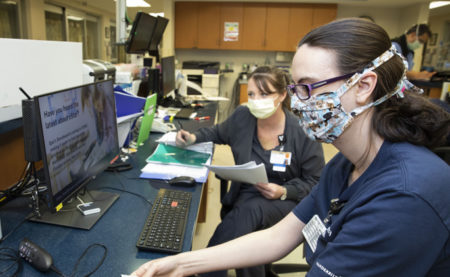In the early evening hours of April 23, Vanderbilt Wilson County Hospital (VWCH) completed most of its transition to VUMC’s clinical and information technology (IT) systems. The change represented a critical step in fully integrating the hospital into the Vanderbilt family.

The transition date of April 23 was established in late 2019, and teams were moving forward as planned when COVID-19 demanded sustained time and resources from VUMC. After careful planning, which included consideration of the health and safety of patients, employees and vendors, the IT team decided to move forward with its original April go live. The team opted to do so primarily because the new software and infrastructure will allow VWCH teams to enhance care for all patients, including those admitted with COVID-19
The IT transition brings several new systems and tools to VWCH, including:
- eStar, VUMC’s Epic-based electronic health record (EHR)
- Laboratory and imaging systems
- Pharmacy systems, including new medication dispending cabinets
- Applications for ordering, administering and monitoring blood products and testing
- Applications for supporting specialty clinical care, including labor and delivery and surgical procedures
- New clinical equipment, such as blood glucose monitors
- New computers, printers and scanners
- Faster and more reliable wireless networks
Staggered throughout the afternoon, the new clinical systems were brought online in a carefully coordinated manner. The transition began in the early morning hours of April 22, as data regarding patients currently admitted to VWCH was loaded into VUMC’s systems. Clinical users, including nurses, executed this “backload” process to ensure the accuracy of the information.
Beginning at midnight, the hospital’s old clinical and technical systems were disabled, and VWCH operated under downtime procedures throughout the night and into Thursday morning. During this time, the transition team, overseen by leaders in an on-site operational command center, focused on activating the new IT infrastructure, including VUMC’s network.
Complementing the command center at VWCH is a technical command center staffed remotely by IT experts from around the Medical Center. In previous “go lives” of this sort, these experts had been co-located in an on-site area, but the realities of COVID-19 and social distancing demanded the team create a virtual solution.
In addition to the IT staff working remotely, many other team members contributing to the transition, including support staff, are virtually participating as well. Enterprise collaboration tools, including Microsoft Teams, Zoom and Skype, are enabling the constant connection necessary for a complex go live event.
These command centers will continue to operate 24 hours a day, seven days a week until VWCH no longer requires that level of support. At that time, the command centers will likely remain open during the day, and team members will be on call for any issues that occur overnight.
According to Jay Hinesley, MHA, president of VWCH, “This IT implementation is the culmination of many months of work and several million dollars of investment. It is just one more way that Vanderbilt Health is demonstrating a commitment to quality and safety in Wilson County.”












